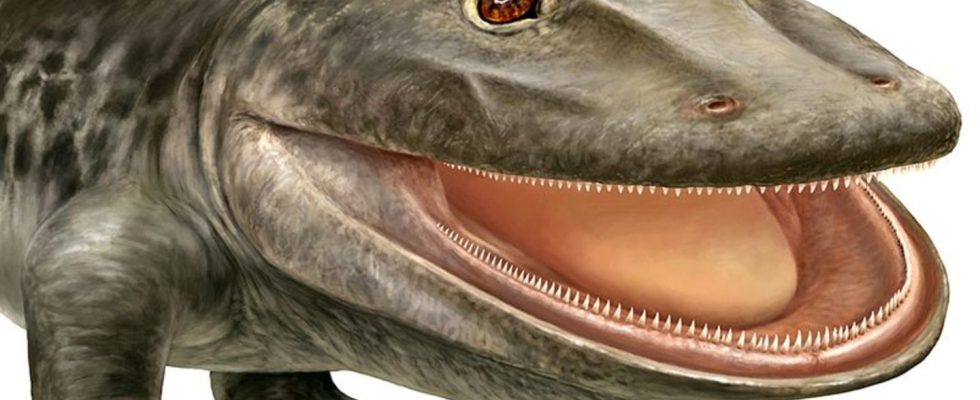paleontology
Funny Ursaur picture becomes a meme
The prehistoric dinosaur with the technical name Stenokranio boldi. According to the museum, the name means something like: narrow-headed eagle. photo
© Dr. Frederik Spindler/Museum of Natural History Berlin/dpa
Scientific presentations rarely go viral. In the case of a Rhineland-Palatinate prehistoric dinosaur, things are different. What the artist and a participating researcher say about it.
Short legs, a stocky build and a large mouth with which it seems to smile: the depiction of a prehistoric dinosaur discovered in Rhineland-Palatinate has caused some joy on social networks. In the past few days, some users have created pictures with it, so-called memes. Among them was comedian Sebastian Hotz (“El Hotzo”), who is followed by 1.4 million people on Instagram. He wrote: “Mr. Lindner, release 100 billion special assets, we have to build a Jurassic Park on Helgoland and clone 100 such rascals.”
Last week, the Museum für Naturkunde in Berlin published a study depicting the animal, which lived around 300 million years ago, and several media outlets reported on it. The museum commented on the many user posts on Instagram on Monday with the words: “Perhaps the oldest Meme of the world!” According to the museum, the prehistoric dinosaur with the technical name Stenokranio boldi was one of the largest predators of its time in the region. This was based on finds in Rhineland-Palatinate. According to the museum, the name roughly means: narrow-headed eagle.
Artist: A more serious facial expression was not possible
When asked on Tuesday, the scientist and paleoartist Frederik Spindler, who made the illustration, was very pleased with the response. “I think it’s nice that the paleo world and the internet world are intertwined,” said the 40-year-old to the German Press Agency. The 3D reconstruction was about showing the essential features. He couldn’t change the facial expression: “I can’t get the animal to look more serious. It’s a bit like dolphins, they can’t look serious.”
Spindler said that he himself was researching similar animals, but actually knew less about amphibians and had been asked by the scientists as an artist.
Even though comments are already asking about Stenokranio fan items, Spindler isn’t thinking that far ahead yet. “A little internet hype that drifts out of the paleo scene should not be exploited.” He also expects the primordial dinosaur to disappear from the timelines again in a few days.
Researchers still see a need for clarification
Spindler said he was simply happy that the term primordial dinosaur had become better known and now had a face, so to speak. As the Berlin museum explained last week, there is no connection with dinosaurs. Rather, it is a popular collective name for the quadrupeds of ancient times. The fact that it is not a dinosaur is also important to the Berlin researcher Florian Witzmann, who was involved in the study: Stenokranio boldi is also not a reptile, as is often incorrectly assumed.
“If we had spoken of Urlurch or Uramphib, that might have been better,” said Witzmann on Tuesday. And despite visual similarities: “Stenokranio boldi is not an ancestor of crocodiles, even if it occupied a similar ecological niche.” Despite some of the misconceptions that are now circulating, Witzmann says he is also happy about the interest.

